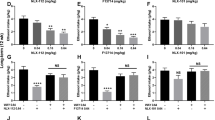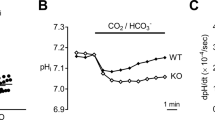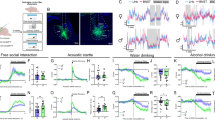Abstract
Substantial evidence links alcohol drinking and serotonin (5-HT) functioning in animals1. Lowered central 5-HT neurotransmission has been found in a subgroup of alcoholics, possibly those with more aggressive, assaultive tendencies2. Several rodent studies3 have also suggested that intact 5-HT systems are important determinants of sensitivity and/or tolerance to ethanol-induced ataxia and hypothermia. Null mutant mice lacking the 5-HT1B receptor gene (5-HT1B–/–) have been developed4 that display enhanced aggression5 and altered 5-HT release in slice preparations from some, but not all, brain areas6. We characterized these mice for sensitivity to several effects of ethanol. Mutant mice drank twice as much ethanol as wild-type mice, and voluntarily ingested solutions containing up to 20% ethanol in water. Their intake of food and water, and of sucrose, saccharin and quinine solutions, was normal. Mutants were less sensitive than wild-types on a test of ethanol-induced ataxia and, with repeated drug administration, tended to develop tolerance more slowly. In tests of ethanol withdrawal and metabolism, mutants and wild-type mice showed equivalent responses. Our results suggest that the 5-HT1B receptor participates in the regulation of ethanol drinking, and demonstrate that serotonergic manipulations lead to reduced responsiveness to certain ataxic effects of ethanol without affecting dependence.
This is a preview of subscription content, access via your institution
Access options
Subscribe to this journal
Receive 12 print issues and online access
$209.00 per year
only $17.42 per issue
Buy this article
- Purchase on Springer Link
- Instant access to full article PDF
Prices may be subject to local taxes which are calculated during checkout
Similar content being viewed by others
References
LeMarquand, D., Pihl, R.O. & Benkelfat, C. Serotonin and alcohol intake, abuse, and dependence: Findings of animal studies. Biol. Psychiat. 36, 395–421 (1994).
LeMarquand, D., Pihl, R.O. & Benkelfat, C. Serotonin and alcohol intake, abuse, and dependence: Clinical evidence. Biol. Psychiat. 36, 326–337 (1994).
Lé, A.D., Khanna, J.M., Kalant, H. & LeBlanc, A.E. Effect of 5,7-dihydroxytryptamine on the development of tolerance to ethanol. Psychopharmacol. 67, 143–146 (1980).
Saudou, F. et al. Enhanced aggressive behavior in mice lacking 5-HT1B receptor. Science 265, 1875–1878 (1994).
Ramboz, S. et al. 5-HT1B receptor knock out — behavioral consequences. Behav. Brain Res. 73, 305–312 (1995).
Piñeyro, G., Castanon, N., Hen, R. & Blier, P. Regulation of [3H]5-HT release in raphe, frontal cortex and hippocampus of 5-HT1B knock-out mice. NeuroReport 7, 353–359 (1995).
Maroteaux, L. et al. Mouse 5HT1B serotonin receptor: Cloning, functional expression, and localization in motor control centers. Proc. Natl. Acad. Sci. USA 89, 3020–3024 (1992).
Saudou, F. & Hen, R. 5-hydroxytryptamine receptor subtypes in vertebrates and invertebrates. Neurochem. Int. 25, 503–532 (1994).
Bruinvels, A. et al. Localization of 5-HT1B, 5-HT1Dα, 5-HT1E and 5-HT1F receptor messenger RNA in rodent and primate brain. Neuropharmacol. 33, 367–386 (1994).
Boschert, U., Amara, D.A., Segu, L. & Hen, R. The mouse 5-hydroxytryptamine1B receptor is localized predominantly on axon terminals. Neuroscience 58, 167–182 (1994).
Koob, G.F. Drugs of abuse: anatomy, pharmacology and function of reward pathways. Trends Pharmacol. Sci. 13, 177–184 (1992).
Belknap, J.K., Crabbe, J.C. & Young, E.R. Voluntary consumption of ethanol in 15 inbred mouse strains. Psychopharmacol. 112, 503–510 (1993).
Terdal, E.S. & Crabbe, J.C. Indexing withdrawal in mice: Matching genotypes for exposure in studies using ethanol vapor inhalation. Alcoholism: Clin. Exper. Res. 18, 542–547 (1994).
Crabbe, J.C., Merrill, C. & Belknap, J.K. Acute dependence on depressant drugs is determined by common genes in mice. J. Pharmacol. Exper. Ther. 257, 663–667 (1991).
Crabbe, J.C., Belknap, J.K. & Buck, K.J. Genetic animal models of alcohol and drug abuse. Science 264, 1715–1723 (1994).
Crabbe, J.C., Gallaher, E.J., Phillips, T.J. & Belknap, J.K. Genetic determinants of sensitivity to ethanol in inbred mice. Behav. Neurosci. 108, 186–195 (1994).
Lagerspetz, K.Y.H., Tirri, R. & Lagerspetz, K.M.J. Neurochemical and endocrinological studies of mice selectively bred for aggressiveness. Scand. J. Psychol. 9, 157–160 (1968).
Linnoila, M. et al. Low cerebrospinal fluid 5-hydroxyindoleacetic acid concentration differentiates impulsive from nonimpulsive violent behavior. Life Sci. 33, 2609–2614 (1983).
Mehlman, P.T. et al. Low CSF 5-HIAA concentrations and severe aggression and impaired impulse control in nonhuman primates. Am. J. Psychiat. 151, 1485–1491 (1994).
Ratey, J.J. & Chandler, H.K. Serenics: Therapeutic potential in aggression. CNS Drugs 4, 256–260 (1995).
Miczek, K.A., Weerts, E.M., Vivian, J.A. & Barros, H.M. Agression, anxiety and vocalizations in animals: GABAA and 5-HT anxiolytics. Psychopharmacol. 121, 38–56 (1995).
Kalant, H., LeBlanc, A.E. & Gibbins, R.J. Tolerance to, and dependence on, some non-opiate psychotropic drugs. Pharmacol. Rev. 23, 135–191 (1971).
San-Marina, A., Khanna, J.M. & Kalant, H. Relationship between initial sensitivity, acute tolerance and chronic tolerance to ethanol in a heterogeneous population of Swiss mice. Psychopharmacol. 99, 450–457 (1989).
Crabbe, J.C., Rigter, H., Uijlen, J. & Strijbos, C. Rapid development of tolerance to the hypothermic effect of ethanol in mice. J. Pharmacol. Exper. Ther. 208, 128–133 (1979).
Phillips, T.J., Crabbe, J.C., Metten, P. & Belknap, J.K. Localization of genes affecting alcohol drinking in mice. Alcoholism: Clin. Exp. Res. 18, 931–941 (1994).
Rodriguez, L.A., Plomin, R., Blizard, D.A., Jones, B.C. & McClearn, G.E. Alcohol acceptance, preference, and sensitivity in mice. II. Quantitative trait loci mapping analysis using BXD recombinant inbred strains. Alcoholism: Clin. Exp. Res. 19, 367–373 (1995).
Melo, J.A., Shendure, J., Pociask, K. & Silver, L.M. Identification of sex-specific quantitative trait loci controlling alcohol preference in C57BL/6 mice. Nature Genet. 13, 147–153 (1996).
Goldman, D. Why mice drink. Nature Genet. 13, 137–138 (1996).
Phillips, T.J., Lessov, C.N., Harland, R.D. & Mitchell, S.R. Evaluation of potential genetic associations between ethanol tolerance and sensitization in BXD/Ty recombinant inbred mice. J. Pharmacol. Exper. Ther. 277, 613–623 (1996).
Crabbe, J.C., Young, E.R. & Kosobud, A. Genetic correlations with ethanol withdrawal severity. Pharmacol. Biochem. Behav. 18, 541–547 (1983).
Author information
Authors and Affiliations
Rights and permissions
About this article
Cite this article
Crabbe, J., Phillips, T., Feller, D. et al. Elevated alcohol consumption in null mutant mice lacking 5–HT1B serotonin receptors. Nat Genet 14, 98–101 (1996). https://doi.org/10.1038/ng0996-98
Received:
Accepted:
Issue Date:
DOI: https://doi.org/10.1038/ng0996-98
This article is cited by
-
Implications of Cannabis sativa on serotonin receptors 1B (HTR1B) and 7 (HTR7) genes in modulation of aggression and depression
Vegetos (2022)
-
Ethanol-Induced Changes in Brain of Transgenic Mice Overexpressing DYRK1A
Molecular Neurobiology (2020)
-
GPCR and Alcohol-Related Behaviors in Genetically Modified Mice
Neurotherapeutics (2020)
-
The 5-HT1B receptor - a potential target for antidepressant treatment
Psychopharmacology (2018)
-
Chronic and acute alcohol administration induced neurochemical changes in the brain: comparison of distinct zebrafish populations
Amino Acids (2014)



